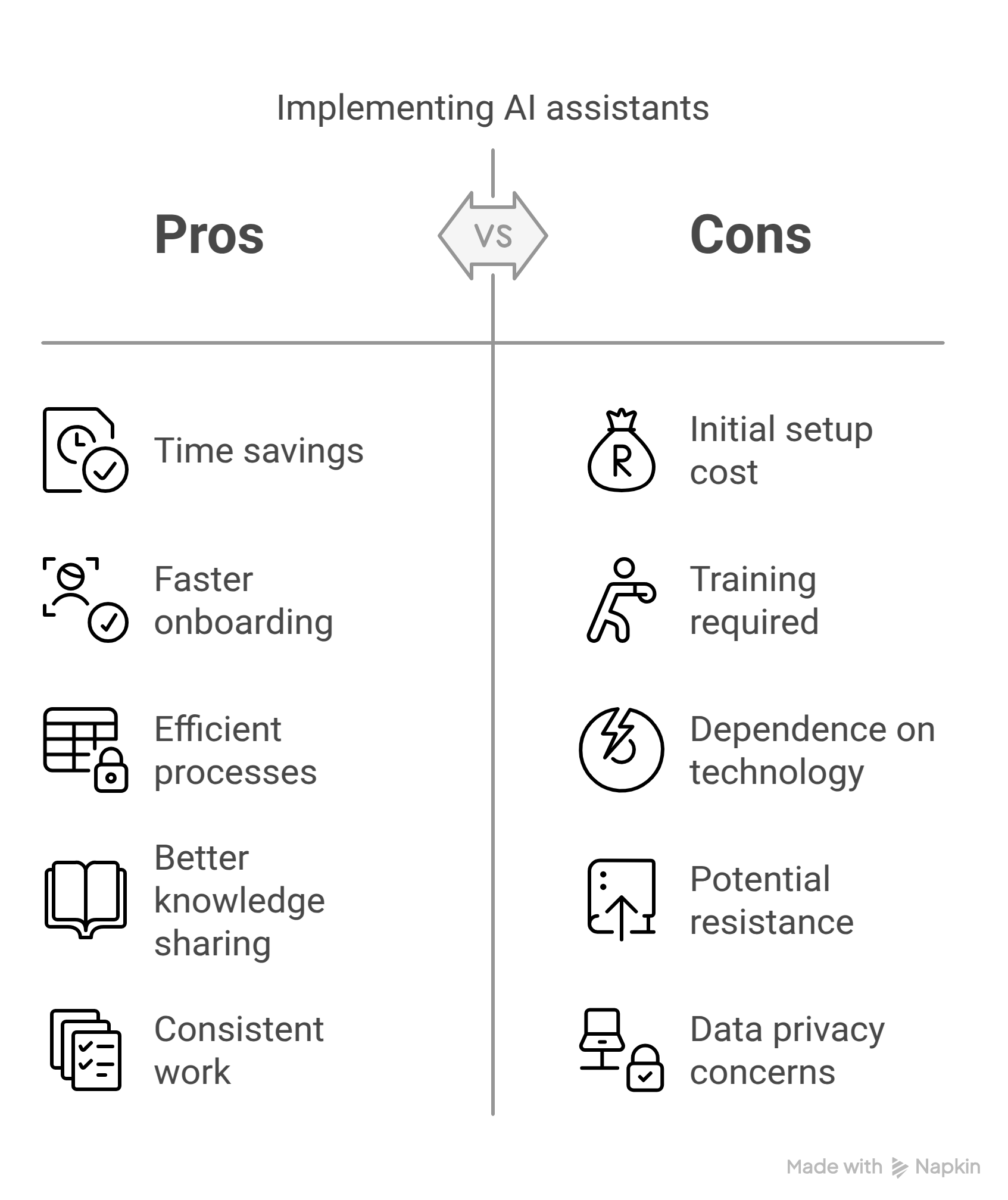
The Information Bottleneck in Modern Organizations
Table of Contents
Complex business environment, employees constantly need access to organizational knowledge from HR policies and IT procedures to product specifications and client information.
Despite substantial investments in intranets, knowledge bases, and documentation, information remains frustratingly difficult to access when needed.
This knowledge access problem manifests in several ways: employees interrupting colleagues with repetitive questions, IT and HR teams spending hours answering basic inquiries rather than addressing complex issues, and productivity losses as staff search through outdated wikis or wait for responses.
The traditional solutions, such as more documentation, additional training, or larger support teams, often create their own problems of information overload and escalating costs.
Meanwhile, organizations face growing expectations for immediate answers from both employees and clients.
The gap between available information and accessible knowledge continues to widen, creating friction that impacts productivity and satisfaction across departments.
Understanding AI Knowledge Assistants for Enterprise
AI IT assistants represent a transformative approach to knowledge management, moving beyond static documentation to provide conversational access to organizational information.
These systems combine natural language understanding, enterprise search capabilities, and machine learning to deliver contextually relevant answers to user questions.
Unlike basic chatbots that rely on predefined responses, modern knowledge assistants understand intent, recognize context, and connect information across previously siloed repositories.
They function as always-available colleagues who know every policy, procedure, and product detail without needing breaks or becoming impatient with repetitive inquiries.
Organizations implementing these systems have experienced substantial improvements in information accessibility.
Teams report significant reductions in internal interruptions and faster resolution of questions, allowing specialists to focus on complex issues requiring human expertise rather than answering routine inquiries.
Key Capabilities That Transform Information Access

Comprehensive Enterprise Knowledge Integration
The AI assistant creates a unified knowledge layer across previously disconnected information sources:
Company policies and employee handbooks.
IT systems documentation and troubleshooting guides.
Product and service specifications.
Client information and account details.
Project documentation and resources.
Training materials and procedural guides.
Internal announcements and updates.
This integration allows employees to ask natural questions without needing to know which system contains the answer. When someone asks, "What's our policy on remote work for contractors?" or "How do I reset my email password?" the assistant draws from the relevant source rather than requiring users to navigate multiple systems.
Organizations with complex product offerings find particular value in the assistant's ability to answer detailed product questions without extensive training. Sales teams can quickly access specifications during client calls, while customer service representatives receive consistent, accurate product information to share with customers.
Struggling with Information Overload?
Discover how AI knowledge assistants can streamline access to company information and boost productivity.

Natural Conversational Interface
The assistant's ability to understand natural language and maintain conversation context creates a frictionless user experience:
Responds to questions in plain language rather than keywords.
Remembers conversation context for follow-up questions.
Adapts to different communication styles and terminology.
Understands company-specific acronyms and jargon.
Asks clarifying questions when user intent is ambiguous.
Supports both text and voice interactions.
This conversational capability dramatically reduces the learning curve for accessing information. Rather than requiring employees to master specific search techniques or navigation paths, the assistant allows them to simply ask questions as they would of a knowledgeable colleague.
Technical support teams appreciate how the system handles follow-up questions without requiring repetition of context. When troubleshooting, team members can ask an initial question about a system issue, then continue with follow-ups like "What about for our remote users?" or "Show me the steps for the latest version instead," without starting over.
Real-Time Assistance and Problem Resolution
Beyond simply providing information, modern AI assistants actively help solve problems:
Guides users through multi-step processes
Generates custom responses based on user-specific variables
Proactively suggests related information that users might need
Updates answers based on recent changes to policies or systems
Escalates complex issues to appropriate human specialists
Learns from interactions to improve future responses
This capability transforms the assistant from a passive information source into an active productivity partner. When employees encounter unfamiliar tasks or procedures, the assistant provides step-by-step guidance tailored to their specific situation.
HR and IT teams report substantial workload reductions for routine inquiries after implementation. The assistant handles common questions about benefits enrollment, expense submission procedures, equipment requests, and basic troubleshooting without human intervention, allowing specialists to focus on complex cases requiring judgment and expertise.
Read Also : Top 10 Ways to Implement AI Strategy 2025
Read Also : Top 10 Ways to Implement AI Strategy 2025
Measurable Business Impact Across Organizations

Productivity Gains Through Reduced Information Friction
The most immediate benefit comes through time savings. Organizations typically report:
Decreased time spent searching for information
Reduced wait times for answers to routine questions
Fewer interruptions from colleagues and subject matter experts
Faster onboarding for new employees
More efficient execution of unfamiliar processes
Reduced duplication of effort through better knowledge sharing
Professional services firms have documented significant productivity improvements after implementing AI assistants. When consultants can instantly access project methodologies, case studies, and client information without interrupting colleagues, they complete deliverables more efficiently while producing more consistent work.
Technology companies find that development teams remain in flow states longer when they can get quick answers to questions about internal systems or code repositories without context switching or waiting for responses from busy colleagues.
Enhanced Service Quality Through Knowledge Consistency
Beyond efficiency, the AI assistant improves the quality of work through:
Consistent application of the latest policies and procedures
Reduced errors from outdated or incorrect information
More complete answers that consider cross-departmental impacts
Better compliance with regulatory requirements
Improved client interactions through faster, more accurate responses
Higher-quality decisions based on complete information
Financial services organizations particularly value this consistency when dealing with regulatory compliance questions. The assistant ensures that all employees receive the same up-to-date guidance on compliance procedures, reducing risk while improving audit outcomes.
Customer service teams report higher satisfaction scores and first-call resolution rates when representatives have immediate access to accurate product and policy information through the assistant. Rather than placing customers on hold or promising callbacks, representatives can answer questions in real-time with confidence.
Operational Insight Through Question Analysis
An often-overlooked benefit is the strategic value of understanding what employees and clients are actually asking:
Identification of knowledge gaps in current documentation
Recognition of emerging issues based on question patterns
Better understanding of actual vs. assumed information needs
More effective prioritization of training and documentation efforts
Insights into potential process improvements
Early detection of misunderstandings about new initiatives
Organizations use this analysis to improve onboarding programs, refine internal communications, and prioritize process improvements. When the assistant receives numerous questions about a particular policy or procedure, it signals an opportunity to clarify communications or simplify the underlying process.
Implementation Considerations for Organizations

While the benefits are substantial, successful deployment requires thoughtful planning:
Begin with high-value knowledge domains - Start with areas generating the most questions or where information access directly impacts productivity
Involve subject matter experts - Ensure specialist input during implementation to validate accuracy and coverage
Establish maintenance procedures - Develop clear processes for keeping information current as policies and systems change.
Create appropriate privacy guardrails - Define clear boundaries for information access based on roles and permissions.
Provide usage guidance - Help employees understand when to use the assistant versus when to seek human expertise.
Solicit ongoing feedback - Create mechanisms for users to report issues or suggest improvements.
Organizations that follow these implementation practices typically see faster adoption and better results from their AI assistant investments.
Implement AI Knowledge Assistance Now
Get a personalized demo and see how AI can optimize information access for your team.

Future Developments in Enterprise Knowledge Assistance
As these technologies continue to evolve, organizations can anticipate several promising enhancements:
Personalized learning experiences that adapt knowledge delivery to individual roles and learning styles
Proactive assistance that anticipates information needs based on calendar events, project milestones, or system activities
Enhanced multimedia support for demonstrating processes through visual guides or short videos
Deeper integration with workflow tools to embed assistance directly within productivity applications
Advanced collaboration capabilities that facilitate knowledge sharing between team members
Organizations laying the groundwork now with current-generation assistants will be well-positioned to leverage these capabilities as they emerge.
Conclusion
AI knowledge assistants represent a fundamental shift in how organizations manage and access their institutional knowledge.
By transforming static information into interactive, conversational guidance, these systems bridge the gap between available data and actionable knowledge.
For leaders seeking to improve productivity while enhancing decision quality, AI assistants offer a solution that addresses both efficiency and effectiveness.
As these systems continue to evolve, they will increasingly become critical infrastructure for competitive organizations, transforming information from a passive resource into an active partner in daily work.
FAQs
How does the assistant stay current with changing information?
Most systems integrate with document management platforms and can be configured to automatically incorporate updates to source materials, supplemented by periodic reviews from subject matter experts.
How do employees typically adapt to using the assistant?
Most users become comfortable with the system within days, especially when introduced through practical examples relevant to their daily work. Adoption typically spreads organically as early users share positive experiences.
What happens when the assistant doesn't know an answer?
Modern systems are designed to clearly indicate when they don't have sufficient information, typically suggesting alternative resources or offering to connect the user with the appropriate human expert.
How does the system handle sensitive or confidential information?
Enterprise AI assistants include robust security controls that limit access based on user roles and permissions, ensuring that sensitive information is only available to authorized personnel.
Can the assistant replace our existing knowledge base and documentation?
Rather than replacing existing resources, the assistant typically works alongside them, providing an improved interface while leveraging the underlying content. This preserves your investment in documentation while making it more accessible.

